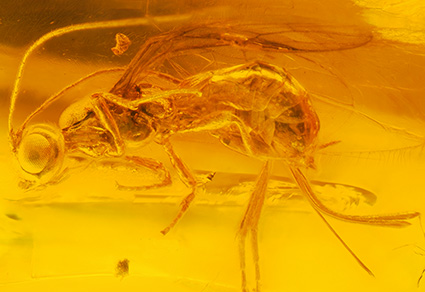Abstract
A new genus and species of the braconid parasitoid subfamily Doryctinae, Palaeorhoptrocentrus kanti Belokobylskij, gen. et sp. nov., from the late Eocene Baltic amber are described and illustrated from two females. This genus is characterised by the fore wing having postfurcal position of the recurrent vein (m-cu), distally closed brachial (second subdiscal) cell, not interstitial parallel vein (CU1a), and short submedial (subbasal) cell in hind wing. Doryctomorpha tertiaria Brues, 1933 is transferred to the genus Palaeorhoptrocentrus gen. nov., P. tertiaria (Brues, 1933), comb. nov. The new genus is compared with the similar extant genera Dendrosotinus Telenga, 1941, Guaygata Marsh, 1993, and Rhoptrocentrus Marshall, 1897.
References
Belokobylskij, S.A. (2014) Family Braconidae. In: Antropov, A.V., Belokobylskij, S.A., Compton, S.G., Dlussky, G.M., Kha-laim, A.I., Kolyada, V.A., Kozlov, M.A., Perfilieva, K.S. & Rasnitsyn, A.P. The wasps, bees and ants (Insecta: Vespida = Hymenoptera) from the Insect Limestone (Late Eocene) of the Isle of Wight, UK. Earth and Environmental Sciences Transactions of the Royal Society of Edinburgh, 104 (3–4), 335–446. https://doi.org/10.1017/S1755691014000103
Belokobylskij, S.A. & Maetô, K. (2009) Doryctinae (Hymenoptera, Braconidae) of Japan. Fauna mundi, Vol. 1, Warszawa, Warshawska Drukarnia Naukowa, 806 pp.
Brues, C.T. (1910) The parasitic Hymenoptera of the Tertiary of Florissant, Colorado. Bulletin of the Museum of Comparative Zoology at Harvard University, 54, 1–125.
Brues, C.T. (1933) The parasitic Hymenoptera of the Baltic amber. Bernstein Forschungen, 3, 4–178.
Muesebeck, C.F.W. (1960) A fossil braconid wasp of the genus Ecphylus (Hymenoptera). Journal of Paleontology, 34 (3), 495–496.
Rasnitsyn, A.P. & Quicke, D.L.J. (Eds.) (2002) History of insects. Kluwer Academic Publishers, New York, Boston, Dordrecht, London and Moscow, 517 pp.
Scudder, S.H. (1890) The Tertiary insects of North America. Report of the United States Geological Survey of the Territories, 13, 1–734. https://doi.org/10.5962/bhl.title.2507
Statz, G. (1936) Ueber alte und neue fossile Hymenopterenfunde aus den Tertiären Ablagerungen von Rott am Siebengebirge. Decheniana, 93, 256–312.
Statz, G. (1938) Neue Funde parasitischer Hymenopteren aus dem Tertiär von Rott am Siebengebirge. Decheniana, 98A (1), 71–144.
van Achterberg, C. (1993) Illustrated key to the subfamilies of the Braconidae (Hymenoptera: Ichneumonoidea). Zoologische Verhandelingen, 283, 1–189.
Yu, D.S., van Achterberg, C. & Horstmann, K. (2016) Taxapad 2016. Ichneumonoidea 2015. Nepean, Ottawa, Ontario. [database on flash-drive]
Zherikhin, V.V. (1978) Development and change of Cretaceous and Cenozoic faunistic complexes. Proceedings of the Palaeontological Institute, 165, 1–197. [in Russian]
Zuparko, R.L. & Poinar, G.O. Jr. (1997) Aivalykus dominicanus (Hymenoptera: Braconidae), a new species from Dominican amber. Proceedings of the Entomological Society of Washington, 99 (4), 744–747.


